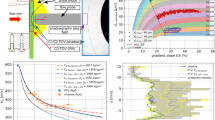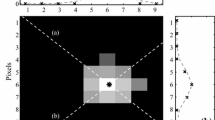Conclusions
-
(1)
This work has evaluated the particle number density measured by a single particle counting instrument, based on either the particle mean velocity or on the particle residence time in the measuring volume.
-
(2a)
In regions where the mean velocity of a size class is near zero the number density should be based on the residence time of the particle, Eq. (3).
-
(2b)
Equation (3) can be used for two-dimensional flow and removes the need to measure the magnitude of the velocity vector, as is the case with the definition of Eq. (1), provided that V(d i ) — and hence A(d i ) — is known. A twochannel laser-Doppler anemometer, however, permits the direct, “on-line” measurement of V(d i ) and A(d i ).
-
(3)
In regions where the mean velocity of all size classes is non-zero, there is little difference in the values of the Sauter mean diameter returned by the two equations.
-
(4)
In instruments which do not have the facility for measuring the residence time, it is suggested that the Sauter mean diameter should be evaluated directly from the measured value of n i .
-
(5)
For instruments based on laser-Doppler anemometry, the correction for the effect of frequency shifting on the cross-sectional area, A(d i ) and volume, V(d i ), of the anemometer is of the order of 25% for small particles and for N f /N 0 = 1.4.
-
(6)
Further work is required to establish the theoretical foundation of Eq. (3) in relation to the work of Buchhave et al. (1979). The accuracy with which C(d i ) can be measured is determined by the tolerances on A(d i ), V(d i ) and z p .Further experimental work is also required to determine the accuracy with which these quantities are known.
Similar content being viewed by others
References
Bachalo, W. D.; Houser, M. J.; Smith, J. N. 1986: Evolutionary behaviour of sprays produced by pressure atomisers, AIAA 24th Aerospace Sciences Meeting, Reno, Nevada, paper AIAA-86-0296
Bachalo, W. D.; Rudoff, R. C.; Brena de la Rosa, A. 1988: Mass flux measurements of a high number density spray system using the phase Doppler particle analyzer, AIAA 26th Aerospace Sciences Meeting, Reno, Nevada, paper AIAA-88-0236
Buchhave, P.; George, W. K.; Lumley, J. L. 1979: The measurement of turbulence with the laser-Doppler anemometer. Ann. Rev. Fluid Mech. 11, 443–503
Capp, S. P. 1983: Experimental investigation of the turbulent axisymmetric jet. Ph.D. Thesis, State University of New York at Buffalo
Dodge, L. G.; Rhodes, D. J.; Reitz, R. D. 1987: Drop-size measurement techniques for sprays: comparison of Malvern laser-diffraction and Aerometrics phase/Doppler. Appl. Opt. 26, 2144–2154
Dunn-Rankin, D.; Hoornstra, J.; Holve, D. J. 1986: In-situ non-Doppler laser anemometer particle sizer applied in heterogenous combustion. Paper 22.1. 3rd Int. Symp. Appl. laser anemometry Fluid Mech. Lisbon: LADOAN-Instituto Suberior Técnico
Holve, D. J. 1986: In situ measurements of flyash formation from pulverised coal. Combust. Sci. Tech. 44, 269–288
McDonell, V.; Milosavljevic, V.; Taylor, A. M. K. P.; Whitelaw, J. H. 1988: Mixing in small-scale non-premixed flames stabilised by swirl; the influence of fuel nozzle geometry. Report FS/88/23. Dept. Mech. Eng. Imperial College, London
McLaughlin, D. K.; Tiederman, W. G. 1973: Biasing correcting for individual realization of laser anemometer measurements in turbulent flows. Phys. Fluids 16, 2082–2088
Saffman, M. 1987: Automatic calibration of LDA measurement volume size. Appl. Opt. 26, 2592–2597
Shih, T. H.; Lumley, J. L. 1986: Second-order modelling of particle dispersion in a turbulent flow. J. Fluid Mech. 163, 349–363
Yeoman, M. L.; Azzopardi, B. J.; White, H. J.; Bates, C. J.; Roberts, P. J. 1982: Optical development and application of a two colour LDA system for the simultaneous measurement of particle size and particle velocity. In: Engineering Applications of Laser Velocimetry, Winter Annual Meeting. Phoenix (eds. Coleman, H. W.; Pfund, P. F.) pp. 127–136. New York: ASME
Author information
Authors and Affiliations
Rights and permissions
About this article
Cite this article
Hardalupas, Y., Taylor, A.M.K.P. On the measurement of particle concentration near a stagnation point. Experiments in Fluids 8, 113–118 (1989). https://doi.org/10.1007/BF00203075
Received:
Issue Date:
DOI: https://doi.org/10.1007/BF00203075




